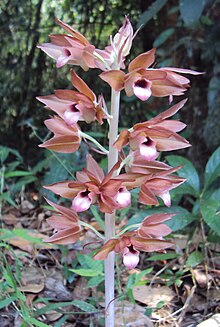Eulophia zollingeri
| Carrion orchid | |
|---|---|

| |
| Eulophia zollingeri near Kottiyoor, India | |
| Scientific classification | |
| Kingdom: | Plantae |
| Clade: | Tracheophytes |
| Clade: | Angiosperms |
| Clade: | Monocots |
| Order: | Asparagales |
| Family: | Orchidaceae |
| Subfamily: | Epidendroideae |
| Genus: | Eulophia |
| Species: | E. zollingeri
|
| Binomial name | |
| Eulophia zollingeri | |
| Synonyms[1] | |
|
show
List | |
Eulophila zollingeri, commonly known as the carrion orchid[2] or 无叶美冠兰 (wu ye mei guan lan),[3] is a plant in the orchid family and is native to areas from tropical and subtropical Asia to Queensland. It is a leafless, brownish terrestrial orchid with up to forty reddish brown, sharply scented flowers with a dark red and yellow labellum. It grows in decaying wood in and near rainforests.
Description[]
Eulophia zollingeri is a terrestrial herb with an underground pseudobulb. It has no green leaves but fleshy, pointed bracts on the flowering stem. Between six and forty reddish brown flowers 40–50 mm (1.6–2.0 in) long and 50–60 mm (2.0–2.4 in) wide are borne on a flowering stem 400–900 mm (20–40 in) tall. The flowers have a sharp, unpleasant odour. The dorsal sepal is elliptic to oblong in shape, 15–23 mm (0.6–0.9 in) long, 4–7 mm (0.2–0.3 in) wide and curves forward. The lateral sepals are more or less oblong in shape, 16–25 mm (0.6–1 in) long, 6–9 mm (0.2–0.4 in) wide and have a pointed tip. The petals are lance-shaped, 11–18 mm (0.4–0.7 in) long, 5–7 mm (0.2–0.3 in) wide. The labellum is dark red, yellow on the outside, oblong to egg-shaped, 14–15 mm (0.55–0.59 in) long, 15–18 mm (0.6–0.7 in) wide and has three lobes. The middle lobe curves downward and has short, thick hairs whilst the side lobes are erect. Flowering occurs between December and February in Australia and from April to May in China[2][3][4]
Taxonomy and naming[]
The carrion orchid was first formally described in 1857 by Heinrich Gustav Reichenbach who gave it the name Cyrtopera zollingeri and published the description in Bonplandia.[5][6] In 1905, Johannes Jacobus Smith changed the name to Eulophia zollingeri.[7]
Distribution and habitat[]
Eulophia zollingeri grows in and near the edges rainforest where there is rotting wood. It occurs in China, Taiwan, India, Indonesia, Japan, Malaysia, New Guinea, the Philippines, Sri Lanka, Thailand, Vietnam and tropical northern Queensland.[2][3]
References[]
| Wikimedia Commons has media related to Eulophia zollingeri. |
- ^ Jump up to: a b "Eulophia zollingeri". World Checklist of Selected Plant Families (WCSP). Royal Botanic Gardens, Kew.
- ^ Jump up to: a b c Jones, David L. (2006). A complete guide to native orchids of Australia including the island territories. Frenchs Forest, N.S.W.: New Holland. p. 359. ISBN 1877069124.
- ^ Jump up to: a b c "Eulophia zollingeri". Flora of China. Retrieved 27 October 2018.
- ^ D.L.Jones; T.Hopley; S.M.Duffy (2010). "Factsheet - Eulophia zollingeri". . Centre for Australian National Biodiversity Research (CANBR), Australian Government. Retrieved 30 May 2021.
- ^ "Cyrtopera zollingeri". APNI. Retrieved 27 October 2018.
- ^ Reichenbach, Heinrich Gustav (1857). "Orchideae Zollingerianae itineris primi recensentur". Bonplandia. 5: 38–39. Retrieved 27 October 2018.
- ^ "Eulophia zollingeri". APNI. Retrieved 27 October 2018.
- Eulophia
- Plants described in 1822
- Orchids of China
- Orchids of Taiwan
- Orchids of India
- Orchids of Indonesia
- Orchids of Japan
- Orchids of Malaysia
- Orchids of New Guinea
- Orchids of the Philippines
- Orchids of Sri Lanka
- Orchids of Thailand
- Orchids of Vietnam
- Orchids of Queensland